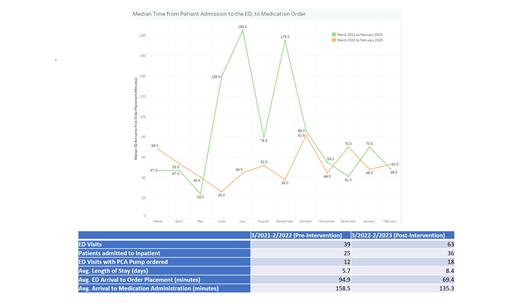CONCLUSION
Sickle cell disease (SCD) is an inherited disease affecting more than 100,000 Black and Hispanic patients in the US. An adult with SCD has an average life expectancy of 54 years compared to 76 years in a typical US adult. This poor survival rate can be attributed to disease and race-related biases, a lack of standardized procedures and dedicated care providers, and delayed or insufficient pain management in the acute care setting. Delays and disparities in care, particularly pain management in acute care setting, have been identified as one of the key deficiencies leading to a decreased quality of care and patient reported outcomes.
This SCD quality improvement project seeks to improve the quality and timeliness of acute sickle cell vaso-occlusive care by utilizing an ED pain pathway, SCD-specific inpatient order sets, and educating providers on care-related biases for patients seeking acute care at Community Health Partners Medical Center (CHP). The primary objective is to improve efficacy, timeliness and patient-centered care in order to optimize health outcomes for patients with SCD seeking acute care at CHP.
This is a collaborative effort between ED, Hospitalist and Pain Management teams. By identifying areas of strength and areas for improvement, we can work towards delivering more efficient, effective, and patient-centered care, ultimately leading to better health outcomes for patients with SCD disease in need of emergency services.
Using the Epic EMR, a metric dashboard was created for SCD patients to measure time from arrival to ED order placement, time from arrival to medication administration, number of inpatient admissions, and length of stay. We focused on crucial time metrics and patient outcomes to gauge the department's efficiency and quality of care for SCD Vaso-occlusive pain crisis.
Our intervention included delivering an educational presentation to the ED providers regarding appropriate recognition and treatment of SCD pain episodes, and by creating ED and inpatient SCD-specific order sets. The baseline data was evaluated from 3/1/2021-2/28/2022, and metrics were followed for one year after implementation of the intervention from 3/1/22-2/28/23.
After implementation, the average time from arrival to ED order placement improved from 94.9 minutes to 69.4 minutes, a difference of 25.5 minutes or 27%. The average time from arrival to medication administration improved from 158.5 minutes to 135.3 minutes, a difference of 23.2 minutes or 14.6%. The average length of stay increased from 5.7 days to 8.4 days, an increase of 2.7 days or 32.2%.
By providing education and SCD-specific order sets, we were able to significantly decrease the total amount of time to medication administration for SCD patients experiencing acute pain crises. While our methods were aimed at ED providers to simplify the input of orders, it did not address the time for nursing to obtain and administer the medication; future improvements could be made towards educating nursing staff to help administer medications sooner. One complicating factor is that these metrics were evaluated during the COVID pandemic, which was responsible for an overall increase in patient admissions and length of stay during this time period. These additional burdens have strained the ability of providers and nurses to provide timely care to SCD patients, though this will hopefully continue to improve as the pandemic recedes. Additionally, the proportion of ED patients who were admitted for further management decreased marginally from 25/39(61%) to 36/63(57%) though the overall number of patients seeking care in our acute care setting has increased. This increase in the number of patients utilizing our acute care may be partly due to an expanding Sickle Cell program at our facility.
This analysis shows that by providing appropriate education and using a standardized order set and pathway, we observed a significant decrease in time to order placement to facilitate a faster administration of medications. While the results indicate positive changes in the acute setting, there are opportunities for continued improvement, particularly in reducing the time from order placement to medication administration to ensure more efficient, effective, and patient-centered care.
Disclosures
Treadwell:Wolters Kluwer Health: Patents & Royalties; Pfizer/Global Blood Therapeutics: Consultancy.


This feature is available to Subscribers Only
Sign In or Create an Account Close Modal